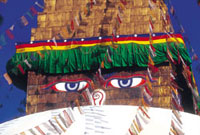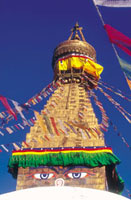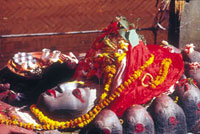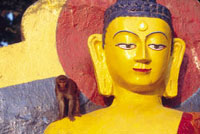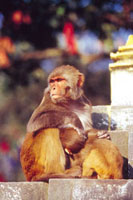35mm In The Millennium
Innovations Can Improve Your Images
The first serious 35mm SLR camera I ever saw (back in 1959, when I was 9 years old) was my dad's Canon VT with screw-in lenses. It was a beautiful, fully manual model. Film was wound via a lever in the camera's base plate. Lenses were focused manually; affordable consumer zoom lenses for 35mm cameras were only a dream. Light readings were taken with a handheld exposure meter. Interestingly enough, with all that manual effort, my dad got some very good pictures, mostly 35mm slides. Today, my dad's camera is retired. These days he uses an auto everything 35mm SLR camera, just like my fellow shooters and I use. Why? Because innovations in electronics and lens design have produced memory recorders, a.k.a. cameras, that make it easier than ever to take great pictures, at the touch of a button. Complementing today's genius 35mm SLR cameras are way-cool films with higher speeds, more color, and less grain than films introduced even in the early 1990s. (Kodachrome is excluded because Kodachrome film and processing have gone virtually unchanged--except for the introduction of Kodachrome 200.) So, here we are at the beginning of the next millennium (even if you think next year is the true start of the millennium). Thirty-five millimeter photography is more exciting than ever. Here's a quick look at some of the coolest (or hottest, if you prefer) innovations--advancements that can help improve your images and your image as a photographer. |
||||
Image Stabilizer Lenses. Canon is the only camera company offering Image Stabilizer or IS lenses (at the time of this writing: 1/20/00). IS lenses, available in zooms and fixed focal lengths, take out the shake that's normally associated with telephoto lenses. Therefore, IS lenses reduce the need for a tripod and increase your chance of getting sharp, handheld pictures in low-light situations. Another IS lens benefit is that you can use a slower film for a finer grain picture because you don't necessarily need to shoot at a fast shutter speed. Zoom Lenses. Just about all of today's zoom lenses are much sharper than those of yesteryear. In fact, pros (myself included) who swore never to use a zoom several years ago now pack them as part of their standard camera gear. What's more, many of today's zoom lenses are sharp throughout the entire zoom range, again, unlike early zoom lenses. What's more, zoom lenses are available in dream focal lengths, like 35-350mm, 28-200mm, and 17-35mm--to name but a few. |
||||
Autofocus. Most photo experts would agree that the first 35mm SLR autofocus systems were humble, to say the least. Cameras and lenses were slow to focus; they also had trouble focusing in low-light situations and on low-contrast subjects. Today, that's all changed. In most situations, top of the line AF SLRs focus faster than we can; some models feature focus assist beams to aid in low-light and low-contrast situations. High-end SLRs offer two focus modes: servo (which lets you lock in the focus on a subject) and continuous (which tracks a subject as it moves toward or away from you). What's more, some SLRs let you change the autofocus point in the viewfinder (to the left or right, for example). And some cameras (Canon only at the time of this writing) feature eye-control focus. This feature sets the focus on the point in the viewfinder at which you are looking. Autoexposure And Auto Bracketing. Built-in exposure meters were big news to my dad--and all the other photographers of his day who had to carry around a handheld light meter. Today's in camera meters, however, do much more than simply read the light. In many SLRs, you have a choice of taking an overall reading of the scene, a center-weighted reading, or a spot reading of a specific area. |
||||
Another important innovation in exposure control is automatic exposure bracketing--a godsend to slide shooters. With this feature, found on many mid-level and top of the line SLRs, you can fine-tune your exposures (sometimes in 1/2 stops and sometimes in 1/3 stops, depending on the camera) over and under the recommended exposure. Auto Daylight Fill-In Flash. For many photographers (again, myself included), pros and amateurs alike, automatic daylight fill-in flash is one of the most important innovations in 35mm photography. This feature calculates the light needed to fill-in shadow areas--automatically. In the past, this was a time consuming and often a picture missing process. Complementing the fill-in flash feature are on-flash diffusers, which attach with touch fasteners to a flash. Some diffusers simply soften the light. Others feature gold and silver inserts to change the color of the light. Gold inserts, for example, simulate the beautiful golden light of late afternoon. Film Scanners. I don't think you can write an article about 35mm innovations without mentioning film scanners. These desktop devices, smaller than a bread box, make it possible to get all your slides and negatives into your computer in a matter of seconds. |
||||
For me, someone who works--and plays--in the digital darkroom, my film scanner helps make me more creative and productive because when I get an idea for a picture, anytime of the day or night, all I have to do is pick out my original image, scan it and proceed to have fun with it on my computer screen. Well, that's a wrap, as they say in Hollywood. Sure, there have been other 35mm innovations like auto film advance and rewind, ergonomic design, sharper tele-converters, full information viewfinders, and easy-to-read LCD panels. And there will be more innovations to come, for sure. Stay tuned to Shutterbug to keep up-to-date on the latest 35mm SLR news. |
- Log in or register to post comments
